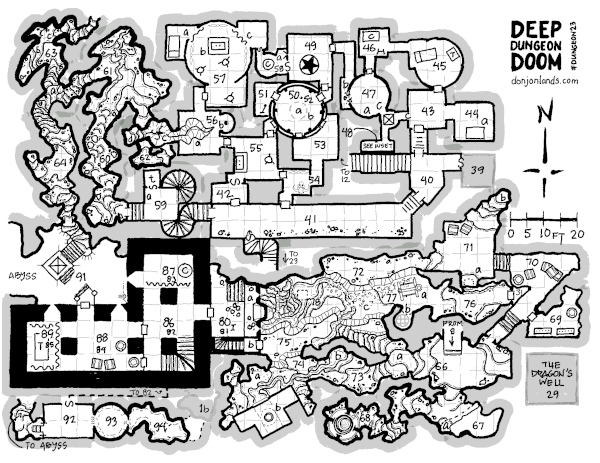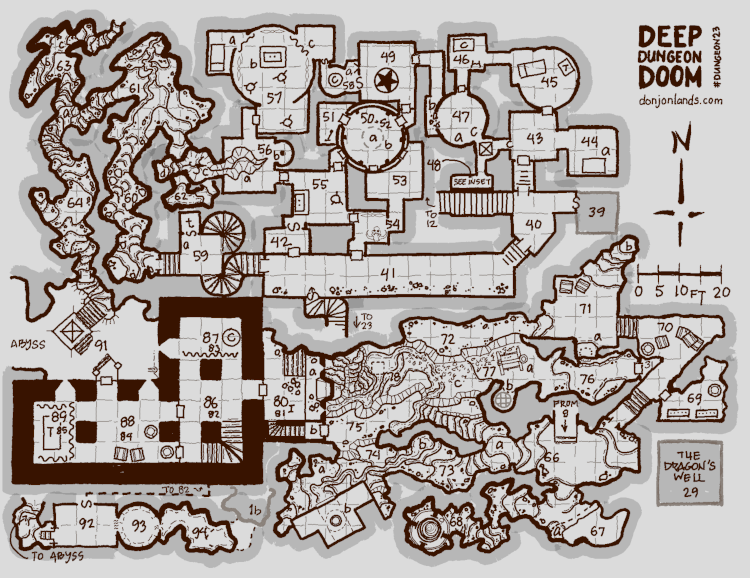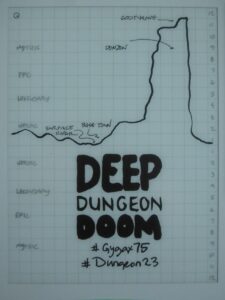In Deep Dungeon Doom, I follow #Gygax75 and #Dungeon23 to create a D&D dungeon campaign in a few minutes per day for one year. I post irregular updates here. To get the daily rooms, follow me on Mastodon.
Progress: For the second time in the year-long daily dungeon-making exercise that is #Dungeon23, I got behind a few days and caught up again in March. Each day’s room often takes me some time more than a few minutes, but I love the work and am so far pleased with the resulting dungeon.
Campaign: Meanwhile, after closing the door on the baalgaur’s prison (Lyceum Arcanum, 9) on the uppermost level, the player party explored the Auditorium’s balcony (2a): The cautious adventurers turned away from three great blades swinging like pendulums in an archway (2d). They then defeated a giant black widow spider (2e), foiled a pit trap in front of a treasure chest (2f), and purloined the gold coins the chest contained. Emboldened by this success, the duo acquired hirelings in Domesday and prepared their second foray into Deep Dungeon Doom.
Ningalgaur [nin-gal-GAW-r]
Named after the nefarious empress and “great lady of demons,” this dungeon region was first used by the demons during their civilization that followed the Illmind’s departure. Most walls, whether natural rock or built from rust-red brick, bare vestiges of relief carvings depicting gruesome faces: bulging eyes, bulbous noses, fat cheeks, wide mouths grinning, lascivious lips, rolling tongues. Since then, a succession of civilizations and empires have connected the former charnel pits with tunnels to create a dense network of rooms and caves.
Now, with its 55 encounter areas (40-94) spread across levels 2 and 3, Ningalgaur may be divided into four sections: Minotaur Maze (NE), Veiled Grotto (NW), Laughing Rift (SE), and Daemningstadr (SW). A brief description of each follows the map.
My thanks again to Tony Dowler for his How to Host a Dungeon: The Solo Game of Dungeon Creation (2nd Edition, Planet Thirteen, 2019), whence I draw the civilizations: demonic, dwarven, and magic-using. You didn’t think I came up with a fortified drinking hall myself, did you?

Minotaur Maze (NE)
A deluded magic-user employs illusion, polymorph self, and a hero henchman in a bull’s-head mask to discourage trespassers. It’s Scooby-Doo meets Theseus and the Minotaur, but that doesn’t mean there isn’t a real minotaur in there.
Veiled Grotto (NW)
A lost pebble sheds an impenetrable darkness throughout these natural caverns filled with noxious molds and creeping animals. Largely considered impassable by the locals.
Laughing Rift (SE)
A deep chasm connects diverse regions of the dungeon, this level and beyond. A mad hermit holes up in natural caverns below a dwarf-built dam on the south rim. Nearby, a magic portal wants repair. Carved tunnels on the north rim are presently inhabited by gnolls, who dispose of their waste in the rift’s nether regions and guard the entrance to Daemningstadr.
Daemningstadr (SW)
Built during the dwarven civilization, Heillwaegg Daemningstadr Drekkenhal—in the common tongue, “Drinking Hall of the Blessed Wall in Dam’s Site”—is a fortified construction, now occupied by members of the Doommaker Cult. The priest-leader’s mission is to destroy remnants of the Gold Flame, which defends the Bastion of Law on Level 1, to make way for the cult’s main objective in the dungeon’s shallow levels: to release the balgaur from its prison in the Infernal Tower.


